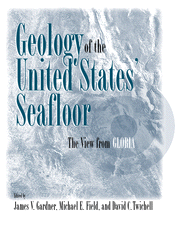Book contents
- Frontmatter
- Contents
- Contributors
- Foreword
- Introduction
- Part I The GLORIA System and Data Processing
- Part II U. S. East Coast EEZ
- Part III Gulf of Mexico and Caribbean EEZ
- Part IV U. S. West Coast EEZ
- Introduction
- 10 Discrimination of Fluid Seeps on the Convergent Oregon Continental Margin with GLORIA Imagery
- 11 A Meandering Channel at the Base of the Gorda Escarpment
- 12 The Morphology, Processes, and Evolution of Monterey Fan: A Revisit
- 13 Ground-Truth Studies of West Coast and Gulf of Mexico Submarine Fans
- 14 Morphology of Small Submarine Fans, Inner California Continental Borderland
- Part V Alaskan EEZ
- Index
11 - A Meandering Channel at the Base of the Gorda Escarpment
Published online by Cambridge University Press: 25 January 2010
- Frontmatter
- Contents
- Contributors
- Foreword
- Introduction
- Part I The GLORIA System and Data Processing
- Part II U. S. East Coast EEZ
- Part III Gulf of Mexico and Caribbean EEZ
- Part IV U. S. West Coast EEZ
- Introduction
- 10 Discrimination of Fluid Seeps on the Convergent Oregon Continental Margin with GLORIA Imagery
- 11 A Meandering Channel at the Base of the Gorda Escarpment
- 12 The Morphology, Processes, and Evolution of Monterey Fan: A Revisit
- 13 Ground-Truth Studies of West Coast and Gulf of Mexico Submarine Fans
- 14 Morphology of Small Submarine Fans, Inner California Continental Borderland
- Part V Alaskan EEZ
- Index
Summary
Abstract
Mendocino Channel lies at the base of Gorda Escarpment on the southern edge of Gorda deep-sea fan about 40 km off Cape Mendocino, California. The channel marks the seaward extension of the Mattole and Mendocino Submarine Canyons and contains several prominent meanders along its length. Based on water-gun and 3.5-kHz seismic records, the channel-levee geometry and structure are similar to deepsea meandering channels reported elsewhere. Over the approximately 50-km section of the channel studied, channel sinuosity and channel slope are about 1.7 and 4.2 m/km, respectively. The valley slope is likely time-variable because of the tectonically induced movements of the southern Gorda Plate upon which the channel is situated. Changes to the valley slope will lead to changes in the meander development during future episodes of turbidity currents. Five (possibly six) turbidite units that have 14C ages ranging from 960 yBP to 3,595 yBP were recovered in box cores from the channel floor. These ages overlap dates of great earthquakes that are estimated to have occurred along the region north of Cape Mendocino. Paleoseismic events are proposed to be the triggering mechanisms for the turbidity currents that deposited the turbidites in Mendocino Channel.
Introduction
With the increased use of swath surveying of the ocean floor, meandering (senso latto) channels have become common features found on the surface of many deep-sea fans.
- Type
- Chapter
- Information
- Geology of the United States' SeafloorThe View from GLORIA, pp. 181 - 192Publisher: Cambridge University PressPrint publication year: 1996



